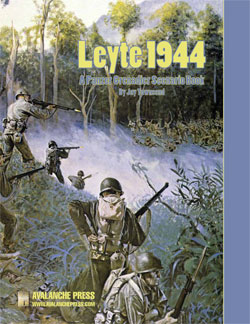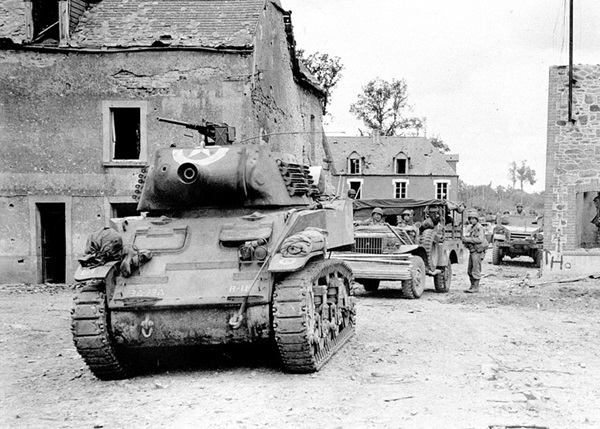| Leyte 1944:
Great Scott!
by Mike Bennighof, Ph.D.
July 2022
 As the United States Army began to acquire tanks in the late 1930’s, its first vehicles – the M1 light tank – carried only machine guns. The follow-on M2 light tank and M2 medium tank added a 37mm cannon (and a prodigious number of machine guns for the medium tank). As the United States Army began to acquire tanks in the late 1930’s, its first vehicles – the M1 light tank – carried only machine guns. The follow-on M2 light tank and M2 medium tank added a 37mm cannon (and a prodigious number of machine guns for the medium tank).
Officers of the 7th Cavalry Brigade, an experimental mechanized unit led by Col. Adna Chaffee and charged with developing doctrine for the use of tanks in combat, considered this inadequate. The tanks needed heavier support, and they drafted a request for a specialized armored support vehicle mounting an M1A1 75mm howitzer, the same “pack howitzer” issued to airborne and mountain units, the U.S. Marine Corps, and the Nationalist Chinese Army.
The resulting prototype, labelled T3, carried the howitzer in the the hull, with a machine gun in a turret. It took its chassis from the M2 light tank, with the howitzer given a rather large oval firing port to allow some elevation. The little assault gun weighed just seven tons, which wasn’t enough to keep the weapon’s recoil from shifting it slightly with each shot fired. It had a crew of just two, a drive and a commander, with the driver expected to operate the howitzer as well as drive the assault gun, and the commander responsible for the machine gun.
The T3 proved a failure; having the same guy load and fire the howitzer, then shift over to drive the assault gun back into position for the next shot was far too burdensome a task, while the commander likewise could not effectively operate the machine gun and command the vehicle.

An M8 Scott of the 3rd Armored Division. Montreuil-sur-Lozon, France, 26 July 1944.
The next two attempts, the T18 based on the new M3 light tank, and the T41 based on the improved M5 light tank, featured a high, open-topped box with the same 75mm pack howitzer mounted within. They were heavier, to absorb the howitzer’s recoil – too heavy, as testing proved. Evaluators also greatly disliked the vehicle’s height, and these prototypes failed as well.
The next prototype, the T47 proposed by Cadillac, moved the howitzer into a fully-rotating, open-topped turret atop the chassis of the new M5 light tank. This new assault gun had a crew of four, just like the light tank, and followed the tank’s layout closely, except for the larger turret ring and the new turret. It also carried a shortened version of the 75mm howitzer, with a huge flash suppressor around it that greatly contributed to the vehicle’s ugly profile. The turret was made of rolled steel, not armor plate, and thus gave protection against small-arms fire but absolutely none against armor-piercing rounds of any size; the howitzer’s mantled was armored, however.
An extra hatch replaced the bow machine gun, to allow stowage of more 75mm rounds (these being considerably larger than the 37mm shells of the M5 light tank’s main armament; the assault gun carried 46 rounds). The .50-caliber machine gun mounted on the rear of the turret for anti-aircraft defense was also expected to defend the assault gun from enemy infantry, even though this meant that the tank commander would have to expose his upper body to fire it.

An M8 Scott of 77th Infantry Division on Leyte. October 1944.
The new vehicle passed its tests in March 1942; the Army 0rdered 2,000 of them in April and it entered production in September of that year. All 1,778 vehicles produced (22 were rejected) came from Cadillac’s Detroit factory, with guns and turrets cranked out by nearby Oldsmobile plants. Few modifications occurred during the production run, and most of those matched improvements to the M5 light tank chassis; the M2 howitzer would be replaced by the slightly improved M3 during the production run. Production ended in January 1944, as the M7 “Priest” self-propelled 105mm howitzer replaced the M8 on the production line; Oldsmobile continued to pump out the turret, which went to the LVT-A4 amphibious assault tractor.
Once accepted for service, the T47 received the designation M8 and the official nickname “Scott” in honor of long-serving General Winfield Scott, best remembered today for his righteous thoughts on the traitors who threatened to disrupt the counting of electoral votes following the 1860 presidential election:
I have said that any man who attempted by force or unparliamentary disorder to obstruct or interfere with the lawful count of the electoral vote should be lashed to the muzzle of a twelve-pounder gun and fired out of a window of the Capitol. I would manure the hills of Arlington with fragments of his body, were he a Senator or a chief magistrate of my native state! It is my duty to suppress insurrection – my duty!
The Scott’s proud name came from the Army Ordnance Department, and not from the troops who used it, and so the name saw little use in the field. Most reports of the time just call them “assault guns” or “75mm assault guns,” leading to some confusion in later popular histories.

Two M8 Scott assault guns on Leyte, October 1944. The vehicle on the right has been modified for beach landings and river wading.
At 17 tons, the Scott had performance not far below that of its light tank predecessor. However, the lengthy development period meant it was somewhat outdated by the time it first rolled off the line. The little assault gun went into action in Italy in 1943, but by the time American forces entered combat in North-West Europe the M8 Scott and its 75mm howitzer no longer gave the desired firepower and it gave way to the close-support version of the M4 Sherman medium tank armed with a 105mm howitzer.
While the M8 Scott saw action in Europe until the close of hostilities, it gave its best performance in the Pacific. Each of the infantry regiments that landed on Leyte in October 1944 had M8 Scott assault guns equipping their cannon companies, rather than the towed 105mm M3 howitzers (a smaller, lighter version of the standard M3) that usually armed the direct-support companies in other theaters. The M8 Scott could squeeze along narrow roads where the Sherman could not go, and its relative lack of protection was less of a liability against the Japanese, whose formations lacked the array of anti-tank weaponry available to the Germans.
The M8 Scott appears in Panzer Grenadier: Elsenborn Ridge, where its kind of overmatched, and in Panzer Grenadier: Leyte 1944, where it comes into its own.
Click here to order Leyte 1944.
Sign up for our newsletter right here. Your info will never be sold or transferred; we'll just use it to update you on new games and new offers.
Mike Bennighof is president of Avalanche Press and holds a doctorate in history from Emory University. A Fulbright Scholar and NASA Journalist in Space finalist, he has published an unknowable number of books, games and articles on historical subjects.
He lives in Birmingham, Alabama with his wife, three children and his new puppy. He will never forget his dog, Leopold.
Want to keep Daily Content free of third-party ads? You can send us some love (and cash) through this link right here.
|
